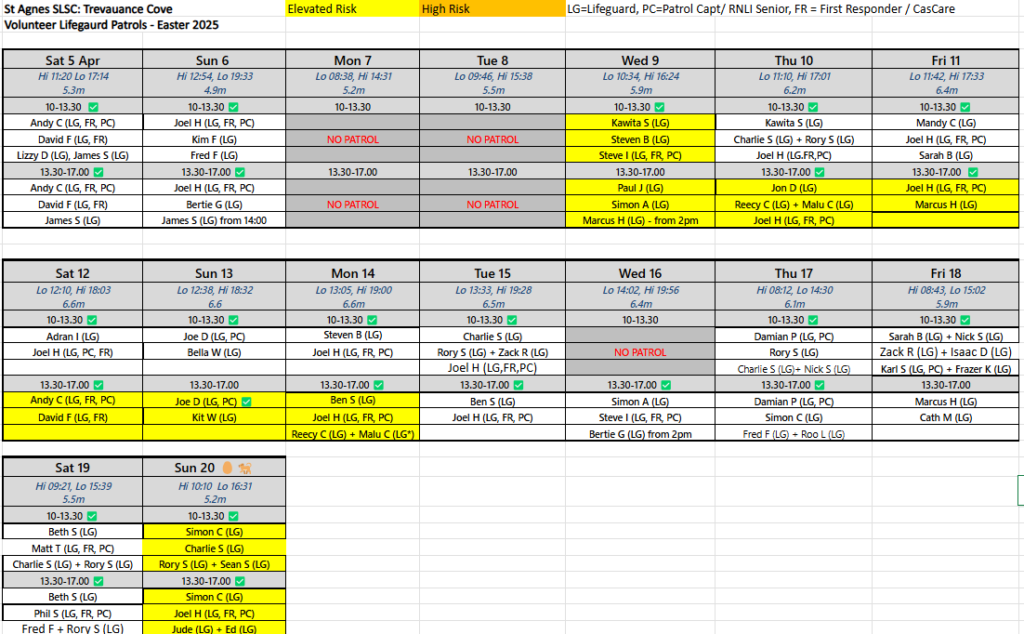Club volunteers are providing lifeguard patrols at Trevaunance Cove. The type and timing of patrols will depend on volunteer availability, we try to target our efforts at higher risk times.
These patrols save lives. If you can be a part of this effort, please consider doing so.

Trevaunance Cove Patrols
We’ve split every day into 2 shifts. You can book any shift you like but tide, surf, weather and human factors will mean that covering certain shifts are likely to have a greater impact than others. If you are flexible, please consider filling higher impact shifts first.

To register, please email your availability to: hello@stagnessurflifesavingclub.co.uk.
Please include a bit of info about your qualifications, experience and age so we can build a solid team.
Surveillance Patrols
A surveillance patrol (Type 1) can be led by someone who has done the SLSGB Coastal Surveillance training or holds a current beach lifeguard award. The surveillance patrol is focussed on prevention and early recognition with appropriate escalation. A surveillance patrol does not establish a bathing area (red and yellow flags). Although a surveillance patrol can be done by an individual, having 2 or more people on patrol is much easier going and facilitates knowledge sharing.
Full Patrols ✅
A full patrol (Type 4) requires a minimum of 2 qualified lifeguards, at least 1 person with the patrol captain award and at least 1 person with the RNLI Cas Care / SLSGB First Responder award. Patrol members also need to make an assessment of their capability and confidence in the conditions before establishing a bathing area. If in doubt, go surveillance!
Getting Qualified
The SLSGB surf lifeguard award is a (min) 35 hour course with swimming, running and lifting requirements. The club generally runs a course starting in June, anyone wishing to enrol should work on their pool swimming over the prior winter. book pool sessions
The SLSGB Coastal Surveillance Award is a knowledge-based award that can be attained in 1 or 2 evenings. It is also a great way to review the basics of beach safety that could help keep you and your family safe at the beach and improve your ability to recognise an emergency and confidence to respond in the best possible way.


… someone is in difficulty?
Call the coastguard: phone 999 or use radio channel 16.
Stay calm, speak slowly and try to give information in an organised way (Position, Problem, People) rather than as a narrative.
ONLY IF you are qualified + capable in the conditions, then:
– Ensure communication with coastguard is maintained at all times.
– Assess risks and make a plan, put the safety of yourself, your team and the public above the safety of the patient. Remember that stabilising the situation or preparing for the arrival of other services can often be a better response than attempting a rescue.
– If risks can be controlled:
– Follow lifeguard SOPs / DR-help-ABCD.
A lifeguard does not have the authority to prevent someone going in the sea. We can only do our best to inform their decision making. The best way to achieve this is to stay calm and present the facts. It’s super important this is kept very neutral, don’t get yourself into a confrontation situation
It’s much easier to control risks when working on a preventative basis than in the response phase of a rescue. Prevention and early intervention reduces the likelihood of an incident developing that might put our coastguard, lifeboat and ambulance crews in situations where risks are MUCH harder to control.

Our patrol documentation can be read in the shared folder, here:
We’re constantly looking to develop our patrol framework, so welcome feedback and new ideas.